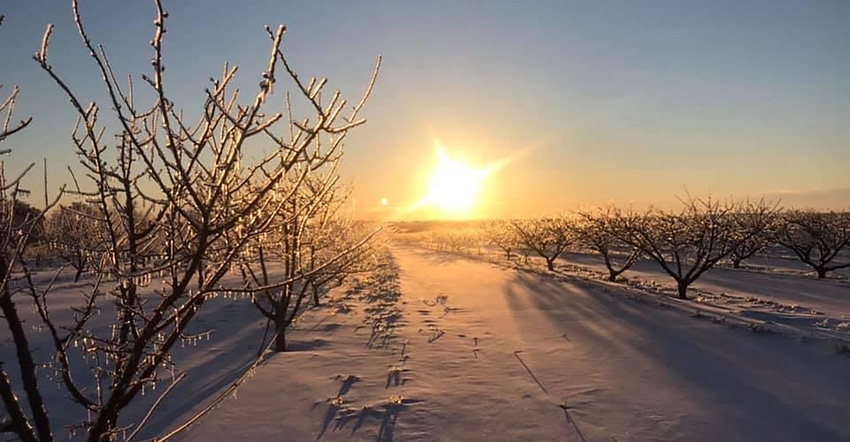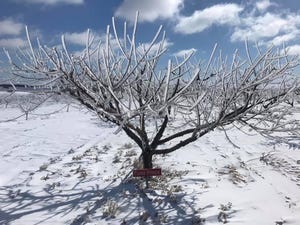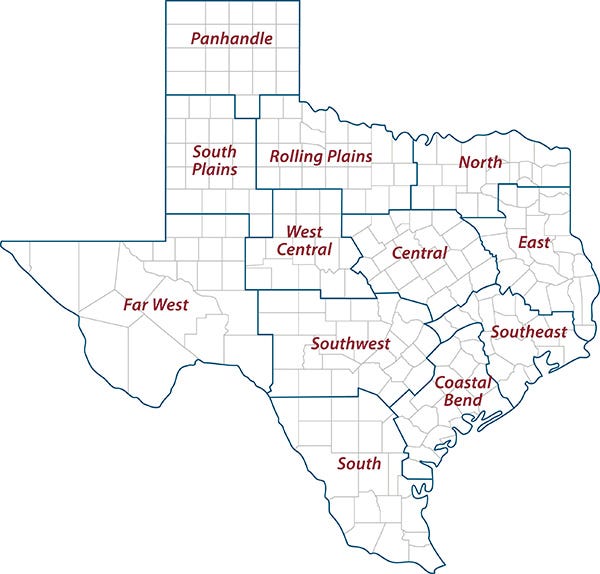
Arctic weather conditions that blanketed the state with snow, ice and frigid temperatures is damaging Texas agriculture crops in a historic way, according to Texas A&M AgriLife Extension Service experts.
The extent of the damage to Texas agriculture won’t be fully realized for weeks, but farmers, their crops and animals are facing tough conditions.
Juan Anciso, AgriLife Extension horticulturist, Weslaco, said the winter conditions rival a historic hit to Texas farmers in December 1989. There were notable freezes that damaged South Texas crops in 2004 and 2011, and a few in prior decades going back to the 1950s, but December 1989 caused severe damage to Texas winter crops, including citrus.
“We’ll know if it ranks with ’89 in a few weeks, but temperatures are well below the threshold for crops and for long periods,” he said. “That’s not a good combination for growers.”

Anciso said the temperature low in Weslaco was 21 degrees. Some crops can tolerate temperatures around 26 degrees for four to five hours, but temperatures were below that for 10-12 hours. A second night of temperatures below the threshold was in the forecast.
The temperatures will affect citrus and cold-season vegetables like leafy greens, onions, beets, parsley and watermelons, Anciso said.
See, Battling through the winter storm
Oranges were frozen solid, and some grapefruits were nearly frozen through, he said.
The good news is that around 80% of the orange crop and two-thirds of the grapefruit crop were harvested before the winter storm, he said. The crop losses will be significant for producers, but the lasting damage could be tree losses.
“A lot of citrus guys are running their sprinklers to insulate their trees,” Anciso said. “They can take the death of limbs up to 1 inch in diameter, but you get into losing 4-inch limbs, you’re effectively crowning the tree. That’s not good.”
Some warm-season crops like potatoes and watermelons and early planted corn and sorghum will also be affected, he said.
Watermelons were being started in high tunnels, which mimic greenhouse conditions, but Anciso said those structures do not provide protection from severe cold. Potatoes could resprout, but yields will be affected. Minimal acres of corn and sorghum have been planted in South Texas, but those acres will require replanting.
Arctic front hits Winter Garden
Texas’ fruit tree and vine crops could also face notable losses.
Larry Stein, AgriLife Extension horticulturist, Uvalde, said temperatures hadn’t reached 1989 levels yet, but that it was 8 to 10 degrees Monday night in the Winter Garden region with 4 to 6 inches of snowfall on the ground. The temperatures likely mean losses for crops like peaches, strawberries, wine grapes, pecans and berries.
Fruit trees and grapevines that had emerged from dormancy would be susceptible to damage, and any active buds or fruit are likely lost, he said.
“Peach trees that had started budding, those buds are going to be toast at 15 degrees,” he said. “Any active growth could be problematic. We could see temperatures pop the wood. We may not see the damage this spring, but eventually those limbs will die back where the tissue is damaged.”
 Ice-covered peach tree limbs. (Photo by Katelyn Eames)
Ice-covered peach tree limbs. (Photo by Katelyn Eames)
Strawberries are a winter-hardy plant that can take temperatures well below freezing, but the fruit and buds on the plant at freezing will be lost, he said. It will take those plants some time in warmer daytime temperatures to bud again, and about three weeks before fruit is ready to harvest.
“Producers were harvesting all the reds and slightly turned fruit they could,” he said. “The plants will survive, but you’ve lost all the flowers and fruit for one harvest.”
Stein said snow may help insulate strawberry plants, but ice will not insulate plants and trees unless water in continuously applied to prevent freezing. Active buds will be lost, and limbs and vines actively growing will be susceptible.
Snow could also help insulate spinach, but the damage to leaves will only be known in the coming weeks as snow melts and temperatures promote growth, he said. The crop could face freeze burn to leaves and blemishes from sleet pellets, which detracts from the marketability due to aesthetic standards at grocery stores.
“I don’t ever remember a weather winter advisory that covered the whole state,” Stein said. “The good news is that we haven’t gone beyond 1989, but the reality is there will be damages, and it will be a few weeks before we access where this winter storm ranks.”
AgriLife Extension district reporters compiled the following summaries:

CENTRAL
Very cold conditions have livestock producers scrambling to meet increased nutritional requirements. Equipment failures were expected due to extreme temperatures. Corn producers were preparing fields for planting. Winter wheat conditions were sporadic, and conditions depended on soil moisture levels. Some fields were tillering and prime for herbicide sprays. Broadleaf and annual grass weed pressure was high, but windy and rainy conditions delayed herbicide applications. Many winter forages including wheat, rye, oats and triticale were covered in ice, and significant crop damage was expected. Producers were expecting hay demand to push bale prices upward.
ROLLING PLAINS
Weather conditions were pleasant over the reporting period, but local forecasts reported some dramatic changes over the weekend. Producers were preparing for single-digit temperatures by securing and insulating water sources along with stocking up on feed and hay. Soil moisture levels remained in decline. Winter wheat was still holding on. Livestock were in fair condition as supplemental feeding continued.
COASTAL BEND
Below average temperatures have producers preparing for hard freezes. The small amount of corn that was planted and emerged will likely need to be replanted. Livestock producers were providing supplemental feed, and a few were running low on hay. Extreme cold, wintery conditions made it difficult for producers to protect livestock, and many water supplies were frozen.
EAST
Temperatures dropped dramatically and even colder temperatures were predicted. Harrison County reported 8-12 inches of snow. Pasture and rangeland conditions were poor to fair. Subsoil and topsoil conditions were adequate. Producers were going through a lot of hay due to the weather. Winter forages were slow growing. Most livestock were in fair to good condition. Cattle markets were better. Wild pigs continued to be active.
SOUTH PLAINS
Conditions were extremely cold with negative temperatures and lower wind chills. Conditions were expected to have an enormous impact on all livestock producers. Temperatures were below freezing for six days and will remain below freezing an additional four days. Stock tanks were frozen over, and watering livestock has been difficult.
PANHANDLE
Subsoil and topsoil moisture were very short in most areas and adequate to short in some areas. Pasture and rangeland conditions were poor to very poor. Winter wheat conditions were fair to poor. Oats were in fair condition. Extreme cold temperatures have cattle producers scrambling to provide more feed and protection for their herds. Body condition scores were expected to decline due to extreme conditions, and losses of cattle and newborn calves were expected.
NORTH
Topsoil moisture was mostly adequate. Producers were getting ready for the extreme cold. The winter storm delivered below freezing temperatures for more than 100 hours as of Feb. 14. Supplemental feed and hay were in high demand.
FAR WEST
Temperatures were in the 70s during the day and the high 30s at night, with highs in the 20s by the end of the reporting period. Oat and wheat conditions were fair to poor. Pasture and rangeland conditions were fair to poor with some reports of good to very poor conditions. Subsoil and topsoil were mostly short with some reports of adequate and very short. Pecan producers were pruning trees. Fields were being prepared for cotton planting, but acres were expected to be down 60%-70% this season. Pecan producers shifted irrigation to alfalfa fields. Hudspeth County reported 4 inches of snow. Livestock were in overall good condition, but the winter weather was expected to impact herds.
WEST CENTRAL
Warm weather gave way to freezing temperatures, ice and snow. Single-digit temperatures were reported in some areas. Soil moisture conditions were mostly adequate with some reports of short soil moisture. Pasture, rangeland, winter wheat and oats were in mostly fair condition. Small grain crops were progressing slowly, and frigid conditions could hurt stands. Winter weather was expected to negatively impact livestock producers. Producers prepared fields for spring planting. Producers were expected to pull cattle off of wheat as soon as possible to cash in on high grain prices. Cattle were receiving heavy supplemental feed, and producers in Coleman County were reporting low to dry stock tanks.
SOUTHEAST
Chambers County reported snow and extreme cold weather like most of the state. Weather was expected to damage winter grasses that were already struggling. A mix of winter precipitation was expected to help soil moisture levels. Rangeland and pasture ratings were excellent to very poor with fair ratings being the most common. Soil moisture levels ranged from adequate to surplus with adequate being the most common.
SOUTHWEST
Some rainfall was reported before temperatures dropped dramatically and delivered sleet and snow. Temperatures have not climbed above 30 degrees for four days. Oat and winter wheat conditions were very poor to excellent. Pasture and rangeland conditions were mostly poor with some areas reporting fair to very poor conditions. Soil moisture levels were very short to adequate. Water tanks for cattle were freezing, and supplemental feed was necessary. Travel was difficult to impossible in some areas.
SOUTH
Temperatures were warm and dry before the strong cold front brought extreme cold temperatures and drizzle to the area. Producers were preparing for the growing season. Corn was emerging in Jim Wells County, and the freezing temperatures were expected to damage the crop. Irrigated fields in Hidalgo County were being pre-watered. Citrus and sugarcane harvests were continuing. Pasture and rangeland conditions were improving where rain had fallen in the past few weeks, but still struggling in other areas. Producers were hauling hay and supplemental cubes in several counties in anticipation of the cold weather. Beef cattle conditions were being impacted as the cattle were not use to the inclement weather.
Read more about:
CitrusAbout the Author(s)
You May Also Like




